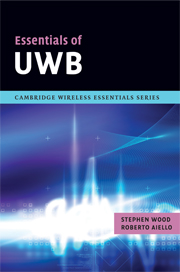Book contents
- Frontmatter
- Contents
- 1 Introducing ultra-wideband (UWB)
- 2 Matching UWB to HDR applications
- 3 Physical-layer (PHY) characteristics
- 4 Media-access control (MAC) layer
- 5 Implementation information
- 6 Upper-layer protocols
- 7 Ultra-wideband standardization
- 8 Special-interest groups
- 9 Ultra-wideband business issues
- 10 Regulating ultra-wideband
- 11 Tragedy of the commons
- Appendix: Reference documents
- Author biographies
- Index
- References
7 - Ultra-wideband standardization
Published online by Cambridge University Press: 22 August 2009
- Frontmatter
- Contents
- 1 Introducing ultra-wideband (UWB)
- 2 Matching UWB to HDR applications
- 3 Physical-layer (PHY) characteristics
- 4 Media-access control (MAC) layer
- 5 Implementation information
- 6 Upper-layer protocols
- 7 Ultra-wideband standardization
- 8 Special-interest groups
- 9 Ultra-wideband business issues
- 10 Regulating ultra-wideband
- 11 Tragedy of the commons
- Appendix: Reference documents
- Author biographies
- Index
- References
Summary
To start this discussion on standards, one should understand that UWB standards and specifications will not be generated by a single standards organization. There are a number of organizations involved in the effort and each of these is engaged for a specific purpose. The following overview gives a flavour of how the division of labour is structured between Ecma International (Ecma), the International Standards Organization (ISO) and the European Standards and Technical Institute (ETSI) in the development of UWB.
Ecma International
The standards organization leading the effort in the development of the UWB physical layer (PHY) and the media access control layer (MAC) is Ecma International. Ecma was initially focused on developing standards for the European computer markets when it was created in 1961, [1] but has since expanded its charter to cover standards in software, consumer electronics and communications on an international scale. Ecma is responsible for developing such well known standards as the DVD (digital video disc) and emerging standards such as near-field communications (NFC), which uses inductive coupling to establish a link between smart cards (credit cards) and their readers. As a side note, the NFC techniques are likely to emerge as a means of association in next-generation wireless LAN and PAN devices.
In UWB, the two principal standards that Ecma is developing are ECMA 368 [2] and ECMA 369.
- Type
- Chapter
- Information
- Essentials of UWB , pp. 103 - 114Publisher: Cambridge University PressPrint publication year: 2008



